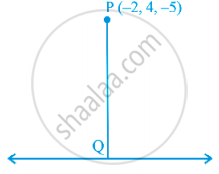Advertisements
Advertisements
प्रश्न
Find the distance of the point (– 2, 4, – 5) from the line `(x + 3)/3 = (y - 4)/5 = (z + 8)/6`
उत्तर
Here P (–2, 4, – 5) is the given point.
Any point Q on the line is given by `(3lambda - 3, 5lambda + 4, (6lambda - 8)`
`vec"PQ" = (3lambda - 1) hati + 5lambdahatj + (6lambda - 3)hatk`.
Since `vec"PQ" ⊥ (3hati + 5hatj + 6hatk)`, we have
`3(3lambda - 1) + 5(5lambda) + 6(6lambda - 3)` = 0
`9lambda + 25lambda + 36lambda` = 21
i.e. `lambda = 3/10`
Thus `vec"PQ" = - 1/10 hati + 15/10 hatj - 12/10 hatk`
Hence `|vec"PQ"| = 1/10 sqrt(1 + 225 + 144)`
= `sqrt(37/10)`.
APPEARS IN
संबंधित प्रश्न
Find the distance between the pairs of points:
(2, 3, 5) and (4, 3, 1)
Find the distance between the following pairs of points:
(–3, 7, 2) and (2, 4, –1)
Find the distance between the following pairs of points:
(–1, 3, –4) and (1, –3, 4)
Find the distance between the following pairs of points:
(2, –1, 3) and (–2, 1, 3)
Show that the points (–2, 3, 5), (1, 2, 3) and (7, 0, –1) are collinear.
Verify the following:
(0, 7, 10), (–1, 6, 6) and (–4, 9, 6) are the vertices of a right angled triangle.
Find the distance between the points P and Q having coordinates (–2, 3, 1) and (2, 1, 2).
Using distance formula prove that the following points are collinear:
A(4, –3, –1), B(5, –7, 6) and C(3, 1, –8)
Using distance formula prove that the following points are collinear:
P(0, 7, –7), Q(1, 4, –5) and R(–1, 10, –9)
Using distance formula prove that the following points are collinear:
A(3, –5, 1), B(–1, 0, 8) and C(7, –10, –6)
Show that the points A(1, 3, 4), B(–1, 6, 10), C(–7, 4, 7) and D(–5, 1, 1) are the vertices of a rhombus.
Prove that the tetrahedron with vertices at the points O(0, 0, 0), A(0, 1, 1), B(1, 0, 1) and C(1, 1, 0) is a regular one.
Show that the points (3, 2, 2), (–1, 4, 2), (0, 5, 6), (2, 1, 2) lie on a sphere whose centre is (1, 3, 4). Find also its radius.
The centroid of a triangle ABC is at the point (1, 1, 1). If the coordinates of A and B are (3, –5, 7) and (–1, 7, –6) respectively, find the coordinates of the point C.
If the distance between the points P(a, 2, 1) and Q (1, −1, 1) is 5 units, find the value of a.
The distance of a point P(a, b, c) from x-axis is ______.
Find the angle between the lines `vecr = 3hati - 2hatj + 6hatk + lambda(2hati + hatj + 2hatk)` and `vecr = (2hatj - 5hatk) + mu(6hati + 3hatj + 2hatk)`
Find the equation of a plane which is at a distance `3sqrt(3)` units from origin and the normal to which is equally inclined to coordinate axis
Find the distance of a point (2, 4, –1) from the line `(x + 5)/1 = (y + 3)/4 = (z - 6)/(-9)`
Find the shortest distance between the lines given by `vecr = (8 + 3lambdahati - (9 + 16lambda)hatj + (10 + 7lambda)hatk` and `vecr = 15hati + 29hatj + 5hatk + mu(3hati + 8hatj - 5hatk)`
The distance of the plane `vecr * (2/4 hati + 3/7 hatj - 6/7hatk)` = 1 from the origin is ______.
